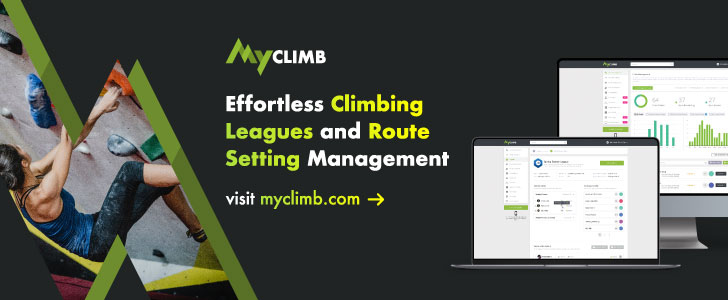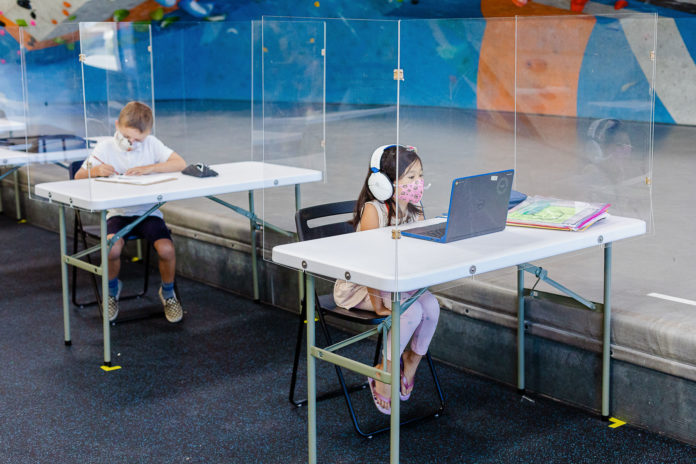
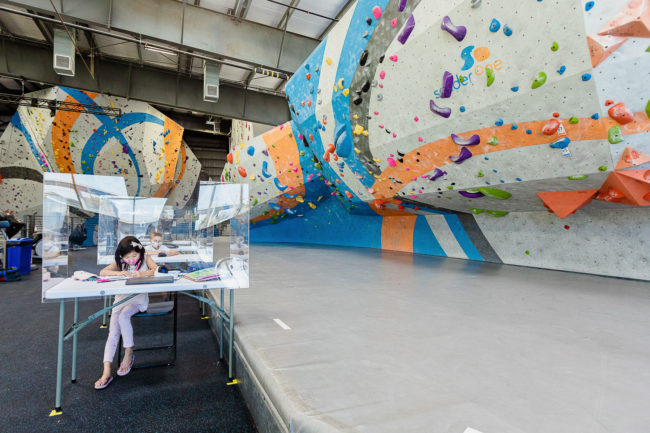
As the pandemic crisis drags on, climbers have continued to get creative in navigating the challenges of this period. Virtual USAC competitions are starting this month, and gyms have been getting creative with non-competitive programs too.
The start of a new school year has looked quite different for parents and students this fall. Some school districts have reopened with remote classes only, some with socially distanced in-person classes, and still others with a hybrid version of these options.
In response, at least one climbing gym has pivoted to meet the demand of working parents looking for a place for their students to study. With their LAX facility still temporarily closed in California’s new tiered system, Sender One shifted its business model to put the facility to good use.
Called the COOL camp (Climb Onward with Online Learning), the camp has been open for 2nd-6th graders since September and includes full-day and partial day options. Registration for the camp even includes a scholarship application for qualifying families financially impacted by this period.
At the same time, Sender One is offering a similar discount on its memberships called the CARE membership (Climbers Aid & Relief Effort). Crystal Tan, Brand Marketing Manager of Sender One, reached out to CBJ about the unique programs and dives into the details below.
CBJ: Thank you for reaching out to CBJ about the COOL camp at LAX. Could you tell me more about how Sender One has shifted its business model in this way, and where the need and idea came from?
TAN: Of course. Sender One has always been pretty focused on and successful with our youth offerings. Our owners are parents and a lot of our employees and members have kids, so we cater pretty fairly to families. Especially with our Sender City area, there’s not really a lot of gyms around here that have that. Our youth program is pretty extensive.
When we closed, the state [of California] allowed camps to operate under certain camp-specific guidelines. We were just trying to pivot as much as we could for a couple reasons: one, to create jobs for our employees and two, to provide a space for family support. A lot of parents were working at home and they needed an option for their kids during summer. And then once school came back into session, there was a need to find something for kids to do. It was impacting the work-at-home situation for many parents.
Our CEO [Alice Kao], is actually in a lot of parent groups and communicates with a lot of other pods. She learned that the YMCA was doing a distance learning program. So we threw the idea out there―and this was at the time when Sender One’s Santa Ana facility was also closed―about how we could use our empty facilities as distance learning centers. A place where kids can come in and we’d basically help them get set up in their daily online classes while helping with homework and then they get to climb afterwards―kind of like a P.E. session. So that’s how that came about.
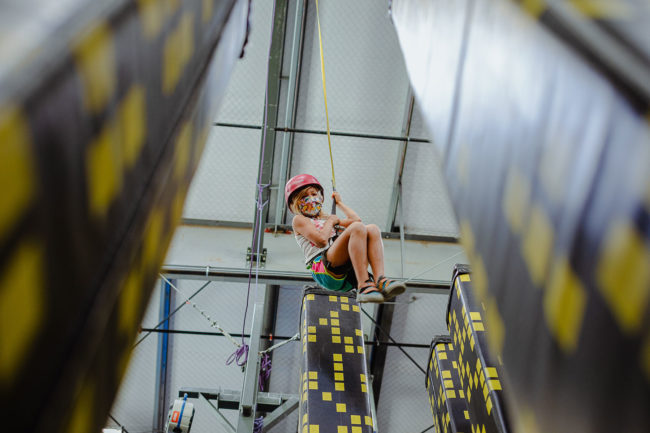
CBJ: There are a lot of details about COOL camp on the Sender One website. What have been the most challenging parts to setting up and running all the logistics and marketing for the camp?
TAN: We actually got a lot of interest for the program once we started marketing. A lot of just “yes I’m interested, send me more information” kind of thing. Then once sign-ups went live and we started accepting applications for enrollment, we didn’t get a ton from Orange County. We were actually surprised and nervous that the program wouldn’t take off after the work we put into developing it. We quickly realized parents just didn’t know what was going on with their child’s school. They were given school schedules like a week before school was supposed to start. They couldn’t actually commit to something when they didn’t know if school was returning in person or online.
I don’t know if you remember hearing that on the news, but there was a lot of talk about whether school was coming back in person, or whether there would be a hybrid version or distance learning. Orange County ended up opening up their schools again and doing in-person classes, and some school districts had hybrid classes. We figured, well with school back in session they don’t really need this program. So we didn’t end up doing it at our SNA facility in Santa Ana, but in Los Angeles the school districts decided on distant learning so we were able to offer COOL camp at our LAX facility.
CBJ: What extra safety measures did you need to put in place around the CA Public Health guidelines?
TAN: Risk was a big factor. Even with our regular rock climbing camps, we had to change the curriculum to be more Covid-friendly. We made sure to enforce the right protocols to meet health standards and follow county and state guidelines. Even though the gym was still empty, we required pick-up and drop-offs outside. We still did health checks every time the kids came in. We continued to take into consideration the cohorts, et cetera et cetera. The guidelines in California requested that the same kids stay with the same counselors during each camp session to avoid mixing cohorts. Another benefit to that is that the kids get to know the counselors, so they can become more comfortable around them and it really creates a better experience. Major shout out to our camp counselors for their hard work! There were so many different things that we just had to learn about and adapt to, which I think everybody has been doing this year.
CBJ: I imagine operating a youth program during the workday could be considered day care in the eyes of the state. Plus there must be meals throughout the day. How did you navigate these requirements?
TAN: Let’s be clear, we are not a daycare. We run day camps and focus on the state’s camp specifications versus operating as a daycare. There’s way more required to be considered a daycare. In terms of what the kids were learning through their online classes, we were not responsible for teaching them the subject(s). Our goal was to be support for distant learning and offering a space for kids to study and climb in a day camp format.
We normally provide snacks for our campers, but given new regulations, we asked campers to bring their own snacks. We set up ez-ups, tables, and chairs for the kids to take breaks and eat their snacks in an open-air setting outside. We learned what was acceptable and adapted while making sure all our camps continued to provide great experiences for the kiddos.
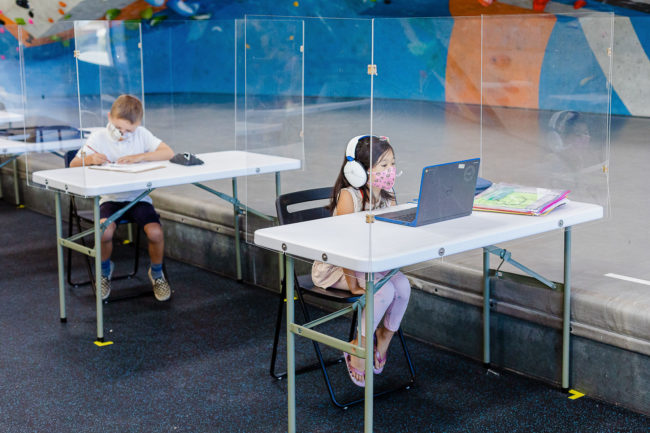
CBJ: I saw on the Sender One website that a scholarship application can be filled out. Where did the idea and funds for that come from?
TAN: We did not focus on making money during the pandemic. We created these programs to build jobs, cover payroll and whatever expenses needed to establish said programs. For the scholarship―and actually this is a good segue into the CARE membership―we looked at the average unemployment rate in California at the time and made a decision based on that. The unemployment rate was continuing to rise so we made sure it would apply to those who qualify for unemployment or are currently on unemployment. We wanted to make sure the camp was available for families that need the distance learning support but may not be able to afford the full price.
CBJ: Before I let you go, I just wanted to talk briefly about the CARE membership at the SNA gym. How have you been able financially to offer discounts for unemployed individuals?
TAN: I was reading an article—maybe it was a Wall Street journal article—saying businesses are going to have to alter their pricing model and possibly change some of their offerings. Many companies may operate differently if they survive through this economic downfall. So we just put it on the table, questioning what we need to do. We decided to create an option for those who have been financially impacted and made it ~30% off our monthly rate. So far, we’ve had a positive response to it and have had a good amount of people who have signed up through the CARE Membership. It’s something we want to offer now and reevaluate later to see if we want to extend it, in relation to how the trends are going with unemployment. We’re still working on what we’re going to do with our pricing plan, but in terms of the CARE membership, it’s going to serve who it needs to serve within our community and we hope it can help even a little bit.
CBJ: Would you consider offering the CARE membership even after the pandemic?
TAN: I think we’ll definitely consider extending it. However, we have two really large sales every year. We do a Black Friday sale and we do an anniversary sale, which heavily discounts our membership as is. We offer a lot of opportunities at discounted rates for our membership as alternatives, so it’s hard to say. But we will consider it for sure.
CBJ: I can imagine it’s tough for folks to talk about unemployment. How have you navigated that?
TAN: It hasn’t been an issue because we do it under confidence and never, ever share the information provided. Anybody who is on the CARE membership is asked for proof in a way where it does not become public information as to respect the privacy and confidentiality of the individual.
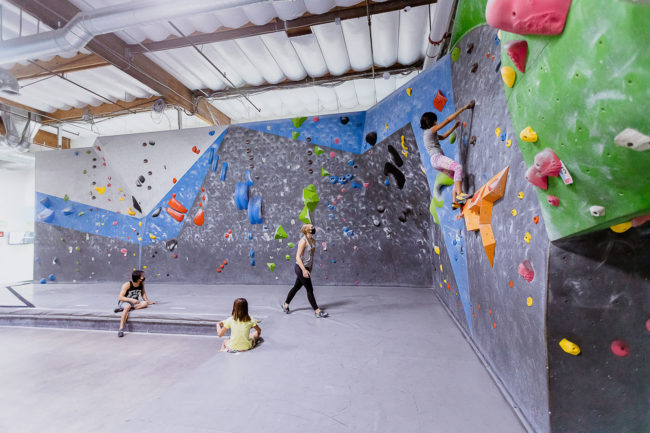
CBJ: Are there any other unique things you all have been doing after reopening you want to mention?
TAN: Um, we’ve just been running a ton of camps. We ran our regular summer camps, and now we’re rolling into our fall and winter camps, which we just recently launched and we’re already getting sign-ups for. We did a really cool camp―well, it’s not THE COOL camp, but it’s another cool camp [laughs]. We hosted a routesetting camp for kids. It catered to our competitive team and other youth who climb at neighboring climbing centers. We felt it was a way for them to have an outlet, to get back into a rhythm and also learn a little bit about routesetting. The kids got to learn about competition routesetting and a bit about commercial routesetting while setting their own climbs. We thought that was a really neat thing to do.
And now we’re doing a competition camp, which is strictly focused on competitive climbing for youth who are participating in 2020-2021 USAC competitions. So that’s happening in November and January. That information can be found on our LAX website under camps. That’s where we’re doing a lot of our primary camps because we’re still closed there. For the specific camps―COOL camp, routesetting camp, comp camp―those are all happening at LAX. Our general climbing camps that we would normally run year-round are happening at both [LAX and SNA].
Additionally, we’re still offering daily virtual yoga classes and have even been able to do some in-person, outdoor yoga and fitness classes at SNA.
CBJ: Do you have anything else to add that my questions didn’t cover?
TAN: I think just that Sender One is not alone when developing these types of offerings and programs, because I think a lot of other climbing gyms have put in work to come up with ways to utilize their business while closed. For example, we opened an online shop, and I know some other gyms did the same. A lot of people have had to maneuver their business model to be virtual. We also got to learn about what other climbing gyms have been doing during CWA’s Survive & Thrive workshop.
I can only speak for California, but the reason I reached out is because I haven’t heard of another gym doing a distance learning camp in the state. I had this thought while we were developing it, “What if all the climbing gyms came together and provided some distance learning thing?” — or really any sort of support camp to help our communities because the whole state is going through this. I reached out wanting to share about our program to provide the possibility of what our climbing gyms can offer back to our communities. It’s our members and the people who are coming back to us after we’ve reopened, those are the people that are sticking with us and going to support us until the end. And hopefully that end doesn’t come, but I was just hoping these ideas would give people inspiration and to see what things are possible.
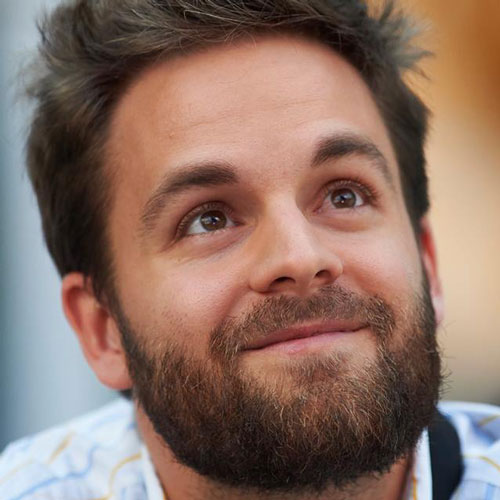
Joe Robinson has been working in the climbing industry for over a decade and currently manages CBJ editorial. He traveled the world as the IFSC’s community manager during Olympic inclusion and across the U.S. while writing for Alpinist, Climberism, DPM and CBJ. He also worked in local climbing gyms of the Pacific Northwest and West Michigan while advancing economic empowerment, educational equity, youth development and diversity programs of national nonprofit organizations.





